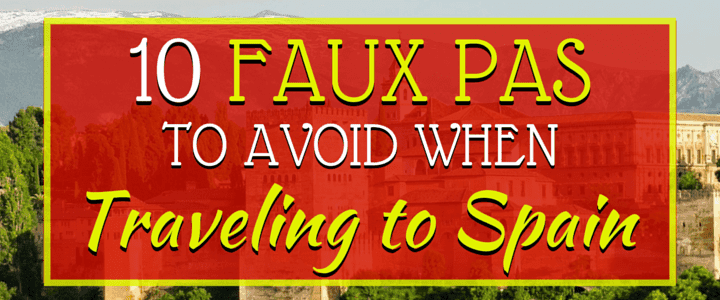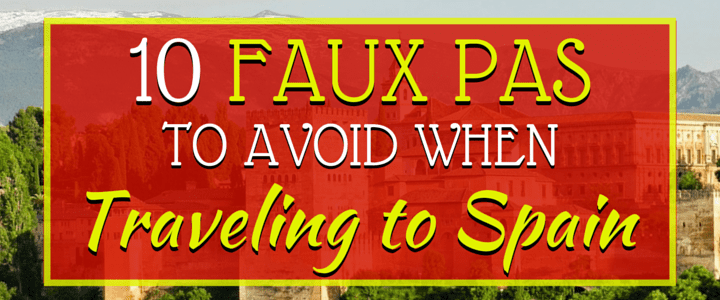Want to avoid looking like a tourist during your trip to Spain? In this post, you’ll first learn about some of the top destinations in Spain… then, tutor Emmanuel M. explains what NOT to do while you’re there!
Spain is known as a beautiful, romantic, and overall wonderful place to visit. Tourists across the world visit Spain to explore the local sights, food, and traditions. You’ll find that the people of Spain tend to be laid-back, good-natured, and cheerful — and there are plenty of options for destinations, from hidden gems of Spain to the more well-known tourist attractions.
The Top Places to Visit in Spain
Located on the Iberian Peninsula in Europe, Spain is a popular travel destination. This beautiful nation is home to stunning coastlines, islands, mountains, and more. Here is a look into five of the top places to visit in Spain.
Barcelona
Barcelona is one of the most popular tourist destinations in the world — and for good reason! The city has a little bit of everything, including unique architecture, exciting activities, and beautiful beaches.
One of the most interesting areas to explore is Las Ramblas. This district in the old part of the city is open to pedestrians. In this lively area, you’ll find shops, restaurants, live performers, artists, and more.
Another must see is La Sagrada Familia. This large cathedral is visited by more than 2 million people each year. Although construction began in 1882, the building is still in progress and scheduled to be completed in about 20 years.
Want to add a quick stop to this beautiful city to your travel itinerary? Check out these tips on how to see the best of Barcelona in two days from American Travel Blogger.
Galicia
Also known as the “land of the 1000 rivers,” Galicia is a picturesque area in northwestern Spain with plenty of old-world charm.
This coastal region is home to some of the best beaches found in Spain, including 105 blue flag beaches. Highlights include San Francisco Beach and Praia das Rodas, which was at the top of The Guardian’s Top 10 Beaches in the World list.
Delicious seafood caught fresh in the ocean is abundant here. One specialty is the percebes, or barnacles. This prized catch is caught by brave fishermen near the cliffs of Costa de Morte, which translates to mean “Coast of Death.”
Andalucia
If you’re interested in learning more about Spain’s bullfighting history, Andalucia is one of the best places to visit in Spain. Since the 15th century, Andalucia has been an important location for bullfighting and rearing. It is home to Spain’s oldest surviving bullring, Plaza de Toros de la Maestranza.
The Cathedral of Saint Mary of the Sea is also located in Andalucia. Built in the 16th century, it is the third-largest church in the world, as well as the burial site of explorer Christopher Columbus.
See Also: Important Spanish Travel Phrases (Video)
Valencia
Valencia is the place to visit in Spain if you are looking for delicious and diverse cuisine. Throughout history, the city of Valencia was invaded and inhabited many times by the Greeks, Romans, and Moors. Each of these cultures influenced the flavors used in cooking, leading to the diverse culinary choices found there today.
In particular, Valencia is known as the birthplace of paella. This traditional dish is prepared over a wood fire in a large pan called a paellera. Typically, a paella will include Spanish rice, olive oil, saffron, tomatoes, and chicken. After you’ve had your fill of paella, visit the Mercado Central de Valencia for cured meats, locally made cheeses, and fresh fruits, including the iconic Valencia oranges.
Madrid
As the capital of Spain, Madrid is one of the most popular places to visit in Spain. It is home to Palacio Real, one of the most impressive palaces in all of Europe. Each of the nearly 3,000 rooms is luxuriously decorated and furnished with marble, stucco, and mahogany.
Along the Gran Via, you will find beautiful, elaborate 20th-century architecture, including the Edificio Metropolis. Also located in Madrid is the Museo del Prado, which is considered one of the world’s greatest art museums.
Now that you know the best places to visit in Spain, it’s time for that trip… right? Not so fast! Before you visit, you’ll want to do a little bit of research so as to not totally look like a tourist. Just like with every country in the world, there are certain cultural faux pas (social “no-no’s”) that you should avoid if you plan on visiting Spain.
Let’s take a look at the do’s and don’ts as you assimilate to some of Spain’s culture and customs:
1. Fashionably late is the norm – NEVER arrive on time!
If you get invited somewhere (whether that’s someone’s house, or a place for a party/get-together), keep in mind that everyone is expected to be late! If you show up on time, either you’ll be the only one there, or the hosts will still be getting ready.
2. Impatience is a sin (unless it’s during traffic).
The people of Spain go about their day with little pressure and no rush. It’s very common to see the locals chatting with clerks at a supermarket or with barbers at a hair salon.
Things go at a very slow pace, so if you show people you’re annoyed or impatient, be prepared to face looks of disgust — unless it’s during traffic, in which case people prefer to move faster so that they can enjoy the rest of their day!
3. Don’t modify ANY food – restaurant or homemade!
For Spaniards, food means the world. Food is undoubtedly part of their culture, passion, and art. So to go anywhere and modify food that’s given to you is like a huge slap in their face. To add a little something (like salt or pepper) to a dish that’s served to you is like saying “You did this wrong — let me show you how to make it better.”
4. Don’t show your disgust or dislike of a food!
Since food is so important to the locals of Spain, if someone gives you a dish that you find appalling, you’d better hide that disgust well; the locals might look at you as an uncultured individual who doesn’t appreciate good food. A good excuse is to pretend you’re full or you couldn’t eat another bite despite it looking really good.
5. Always put up a fight, but let them win when they offer to pay for dinner.
The people of Spain are very generous and kindhearted, so don’t be surprised if they take you out and volunteer to pay for everything. However, they expect you to put up a fight to show you’re being mindful, thoughtful, and respectful of their customs.
Always remember to thank them and be appreciative. If you end up spending your own money on other things or on someone else, make sure you know how to be efficient and save your travel money.
6. Be extremely complimentary of homemade food!
Food, yet again, is an important aspect of Spain’s culture. When you’re going over to a Spaniard’s house and they offer to feed you, always remember to: a) accept the food and eat it (even if you’re full, always accept to eat at least a little bit), and b) compliment whoever cooked the food profusely.
It’s also common to spend the first few minutes of the meal talking about the deliciousness of the food.
7. Do not talk TOO good of other places.
Everyone has pride for their hometown and where they come from — that’s completely normal. However, when visiting Spain, do NOT spend more than a couple of minutes talking about how amazing your home is, because they may get offended. To them, nothing is like Spain — not to mention, they have love-hate relationships with several countries in the world.
Be sure to look at a few Spanish travel blogs to see how fellow tourists converse and interact with the locals.
8. Never bring up racist matters in Spain.
Unfortunately, racism is alive and well in every country. There’s no country out there where even a semblance racism isn’t felt.
But when visiting Spain, NEVER bring up racist issues – remember, you’re a guest, so you may not know the history, current events, public opinions, or customs that all influence racism. They’re well aware of the matters, but they’ll act very defensively because nobody likes speaking about their country’s problems with foreigners.
9. Don’t have a limp handshake or be awkward when hugging or double-cheek kissing.
In Spain it’s customary to give a sturdy handshake to men and a double-cheek kiss to women (and sometimes men). If you give a weak handshake, it’s rude and considered an insult. Also, feeling awkward or uncomfortable when doing the double-cheek kiss makes you seem stuck-up and can also be taken as an offense.
10. Don’t be too polite or well-mannered – Spain is casual and you should be too.
People in Spain love the easy, calm life. They’re very casual and would prefer it if you are too while visiting. If you portray yourself too seriously and well-behaved, locals might think you’re stuck-up, or perhaps they might misinterpret your demeanor as saying you’re better than them. It’s smart to learn a few Spanish phrases for traveling so you can use them in your casual encounters.
As I’ve said many times before, and will continue to say many times more: Spain is an amazing and beautiful place to visit! As long as you remember not to commit these faux pas, you’ll definitely enjoy yourself.
Additional Resources to Check Out Before Your Trip
- Montserrat Mountain, Spain: a Downhill Trip via Wandering Carol
- 10 Best Places to Visit in Spain via Touropia
- 6 Hidden Gems of Spain to Add to Your Bucket List via TakeLessons
- 5 Travel Bloggers to Inspire Your Next Trip to Spain via TakeLessons
- My 10 Favorite Underrated Cities in Spain via Young Adventuress
Emmanuel M. teaches Spanish online. A California State University, Fullerton graduate and native Spanish speaker, he also teaches essay writing, study skills, and singing. Learn more about Emmanuel here!
Photos by Nathan Rupert, Jorge Rodriguez, Harshil Shah, Paco Rubio Ordás, vil.sandi
Suzy S.








